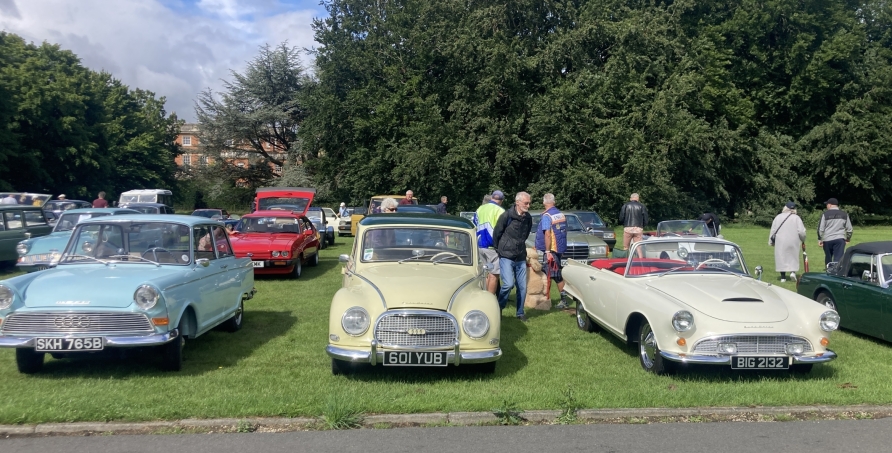DKW motor sport, 1921 – 1965
DKW in motorcycle racing
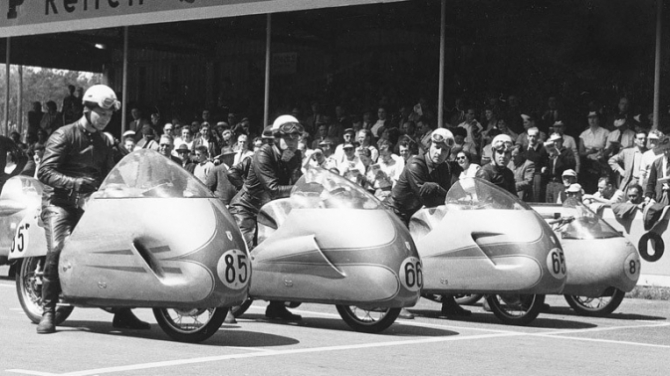
After the First World War, company founder Jörgen Skafte Rasmussen switched his metal fittings factory in Zschopau to the manufacture of two-stroke motorcycles, and from 1921 onward these were successful in competition events. Victory in the ADAC Reich long-distance run in October 1921 was the start of a magnificent series of motor sport successes.
The two-stroke road to success
In the 1920s and 1930s, innumerable championship titles, Grand Prix victories, Six Day Trial successes, off-road events and record-breaking runs demonstrated the outstanding performance of DKW motorcycles and their riders. Arthur Geiss, Walfried Winkler, Ewald Kluge, Toni Bauhofer, H. P. Müller, Siegfried Wünsche and last but not least Bernd Rosemeyer, who later drove Auto Union Grand Prix racing cars, scored many successive victories on DKW motorcycles at international race meetings and in off-road events.
Winning the Tourist Trophy
The highlight of this period of motorcycle racing was a supremely convincing victory in the 1938 English Tourist Trophy race on the Isle of Man by Ewald Kluge, the holder of two European championship titles (1937/1938). He rode a DKW ULD 250 racing motorcycle with a rotary-valve engine, the most significant and successful DKW development in this pre-war period, and the first motorcycle not built in Great Britain to win the “TT” in its 30-year history.
A modest new start in Ingolstadt
In 1946, post-war Germany was still largely clearing away its war damage, but the first motorcycle races were nonetheless being organised. DKW two-stroke bikes were in the forefront from the very beginning. A group of private entrants, among them former works rider H. P. Müller, gained the first successes for DKW on bikes dating from before the war. As early as 1948 and 1949 DKW took the German championship titles in the 125 and 250 cc classes, and in 1949 ex-factory driver Siegfried Wünsche became 350 cc class champion. In the same year Ewald Kluge, the “grand old man” of DKW motorcycle racing, returned to Germany after a period as a prisoner of war.
A new motorcycle racing department
In 1951 Auto Union once more set up a motorcycle racing department in Ingolstadt – and immediately found itself confronted with a major problem: two-stroke engines with charge-pump forced aspiration were banned from the racing circuits. DKW’s racing bikes had to be converted more or less overnight to natural aspiration. The first to appear was a racing version of the DKW RT 125, now shorn of its charge pump, followed by a 250 cc class bike with a twin-cylinder engine.
The “singing saw”
For the 1952 racing season, Auto Union surprised the experts by unveiling a new design. The Ingolstadt-based manufacturer’s new “secret weapon” had a 350 cc three-cylinder engine and a power output of 38 hp at 12,500 rpm. The characteristic sound it made earned it the nickname “singing saw”, which has gone into the annals of motorcycling racing. The new three-cylinder DKW, known as the RM 350, had its first outing in June 1952 on the Eilenriede circuit in Hanover. And what a magnificent debut! The competition was totally overwhelmed. Kluge and Wünsche led easily all the way and crossed the line in first and second places.
The season’s outstanding rider, however, was Siegfried Wünsche, who brought the 1953 German championship title to Ingolstadt in the 350 cc class. In the same year a new young talent, August Hobl, began to ride for the company.
The finest years
In 1954 the RM 350 was extensively redesigned, and entered the 1955 racing season with a more powerful engine, swinging-arm front suspension, a five-speed gearbox and a streamlined fairing. On the new bike, August Hobl came third in the World Championship series and was German
champion in the 350 cc class. Hobl even improved on this in 1956, when he was runner-up for the World Championship title in his class just behind Bill Lomas. In the German Championships he carried off not one but two titles: in addition to his success in the 350 cc class he rode the new 125 cc racing bike, developed from RM 350 components, to victory.
DKW – more successful than any other make in German motorcycle championships
DKW cars began their motor sport career with modest 600 cc twin-cylinder engines developing no more than 15 bhp. A DKW P 15 driven by Gerhard Macher and Gustav Menz, with a wood-framed body covered with imitation leather, reached the finishing line in the 1929 Monte Carlo Rally – an especially remarkable achievement since deep snowdrifts prevented the starting point in Königsberg from being reached except by driving across the ice of the “Haff”.
DKW cars in racing and rallying
DKW cars began their motor sport career with modest 600 cc twin-cylinder engines developing no more than 15 bhp. A DKW P 15 driven by Gerhard Macher and Gustav Menz, with a wood-framed body covered with imitation leather, reached the finishing line in the 1929 Monte Carlo Rally – an especially remarkable achievement since deep snowdrifts prevented the starting point in Königsberg from being reached except by driving across the ice of the “Haff”.
Performance demonstration on Eibsee Lake
Ove Rasmussen, son of the company’s founder, drove the first DKW with front-wheel drive in the Eibsee race in February 1931. Thanks to its front-wheel drive the car was faster than even Bugatti and Amilcar, its strongest rivals, but the sensational demonstration was unfortunately cut short by a slide that ended in a bank of snow.
Success in hillclimbs, circuit racing and off road
Thousands of competition entries followed, and the DKW became the most popular car of its day among active motor sport enthusiasts. Whether with two-stroke engine and front-wheel drive or four-cylinder charge-pump engine and rear-wheel drive, DKW cars were entered in large numbers for all national and international events: on the Avus and Nürburgring cicuits, the International Alpine rally, Liege-Rome-Liege, hillclimbs everywhere in Europe, the East Priussian Run, the Three-day Harz Run, the Brandenburg Off-road Trial. To take the 2000-km German Rally of 1934 as just one example, DKW carried off no fewer than 60 percent of the gold medals. Gustav Menz, Fritz Trägner and Walter Fritzsching were the members of the much-feared “DKW Gold Team”.
1954 European Rally Championship for DKW
When the DKW 3 = 6 Sonderklasse with three-cylinder engine appeared in 1953, it was seized upon immediately by keen motor sport drivers as a promising competition car. In the autumn of that year a new motor sport department was opened in Düsseldorf with the experienced competition driver Karl-Friedrich Trübsbach as its head. The target for 1954 was ambitious: to enter for European Rally Championship events. With drivers Walter Schlüter, Gustav Menz and Heinz Meier, an almost unbelievable success was achieved. In its first season DKW took the first three places in the European Rally Championship rankings, and Heinz Meier also won the German Rally Championship title.
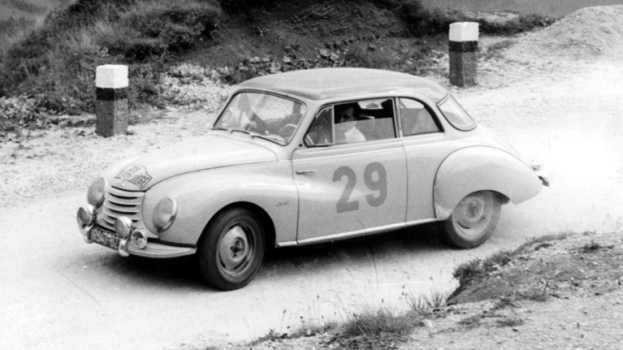
.
World records in Monza
In the years that followed the three-cylinder DKW was a force to be reckoned with in motor sport. The German Rally Championship title was defended successfully in 1955, and third place in the European Championship against very much more powerful competitors also demonstrated the performance potential of DKW’s two-stroke engines. In 1956 a DKW 3=6 Coupé with a special plastic body set five new world speed records on the Monza circuit in Italy, after which a small batch of 3=6 Monza cars was offered for sale.
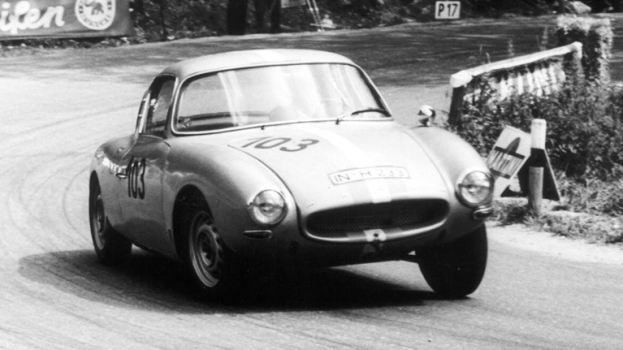
The Auto Union DKW Trophy
Starting in 1956, Auto Union increased factory support for private DKW entrants. An “Auto Union DKW Trophy” was competed for annually from 1958 on. This immediately stimulated interest on the part of an even larger number of active DKW sports car and racing drivers. DKW sport successes increased both in Europe and further afield. There was scarcely any motor sport event without a DKW 3=6, Auto Union 1000, DKW Junior or DKW F 12 among the successful participants. The 900 and 1,000 cc two-stroke racing engines’ power output was steadily increased until they were developing in the region of 100 bhp.
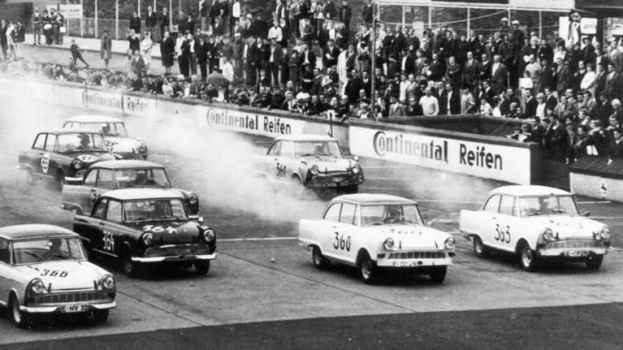
An impressive record
Between 1954 and 1964 DKW drivers won more than 100 championship titles, 150 overall victories, 35 team first prizes and 2,500 class victories. But when the two-stroke era came to an end at Auto Union, the factory withdrew from motor sport in the autumn of 1964, a commitment that was only to be revived ten years later with the first Audi 80 GT and the Audi 50.
Reproduced by kind permission of Alex Fisk at AUDI UK


